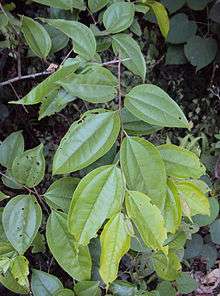Celtis timorensis
| Celtis timorensis | |
|---|---|
 | |
| Leaves of Celtis timorensis | |
| Scientific classification | |
| Kingdom: | Plantae |
| (unranked): | Angiosperms |
| (unranked): | Eudicots |
| (unranked): | Rosids |
| Order: | Rosales |
| Family: | Cannabaceae |
| Genus: | Celtis |
| Species: | C. timorensis |
| Binomial name | |
| Celtis timorensis Span.[1] | |
| Synonyms[2] | |
| |
Celtis timorensis, commonly known as stinkwood or stinking wood is a species of flowering plant in the Cannabaceae family. The specific epithet comes from the name of the island of Timor, the locality of the type collection.[3] In Sri Lanka, it is known as "ගුරෙන්ද - gurenda", where whole plant is an important medicine.
In Thailand, it is known as kæ̂ng k̄hī̂ phrar̀wng or mị̂ chĕd tūd phrar̀wng (Thai: แก้งขี้พระร่วง, ไม้เช็ดตูดพระร่วง; literally: wipe the bottom timber). Due to smell like feces, legend has it that Phra Ruang (the legendary King of Sukhothai dynasty) to wipe feces.[4]
Description
Celtis timorensis is a large forest tree growing to 25 m in height. The wood has a strong foetid smell, because of the presence of skatole. The oblate to oblong, strongly 3-veined leaves are 50–130 mm in length. Although the tree resembles Cinnamomum iners in its 3-veined leaves, it can easily be distinguished by its serrated leaf margins. The seed, protected by the 7–11 mm long fruit’s hard and durable endocarp, is dispersed by water.[3]
Flowers - Inflorescence - male greenish, short racemose cymes; female more slender axillary or terminal cymes.
Fruits - beaked, pear-shaped frupe.
Distribution and habitat
The tree is found across the southern and south-eastern Asian regions, from India and Sri Lanka, through Indo-China, southern China and Malesia to the Philippines. It occurs on Christmas Island, an Australian territory in the north-eastern Indian Ocean, where it forms about 1% of the primary rainforest canopy.[3]
References
Notes
- ↑ Spanoghe (1841).
- ↑ "The Plant List: A Working List of All Plant Species". Retrieved 1 September 2014.
- 1 2 3 Flora of Australia Online.
- ↑ "หายากมาก! "ไม้เช็ดตูดพระร่วง" ในตำนาน จนท.บุกป่าพิสูจน์เจอแค่ต้นเดียว (ชมคลิป)". ASTV Manager (in Thai). September 5, 2016. Retrieved September 6, 2016.
Sources
- Spanoghe, J.B. (1841). Linnaea. 15: 343–344. Missing or empty
|title=(help) - "Celtis timorensis Span.". Flora of Australia Online. Australian Biological Resources Study. 1993. Retrieved 2010-12-02.